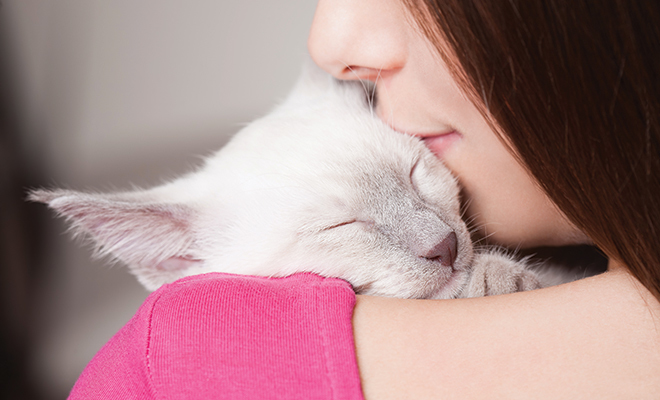
Cracking the kitty code
There was a time when attributing human emotions to our pets’ behavior was considered silly, perhaps especially when it came to cats. Compared with the goofy, expressive nature of dogs, cats are relatively enigmatic creatures that reveal seemingly little about their feelings or motivations.
However, a growing body of research into cat behavior suggests that cats are just as expressive as dogs–if you know how to read them. Here are some of the messages your cat may be sending you.
“Life is good.”
A cat that’s content with the world will look the part; she’ll usually be lying down (perhaps on her back) with sleepy-looking eyes and narrow pupils. Her tail will be primarily still, and her ears will be forward. If she’s having a really good day, she’ll often “make biscuits,” or knead on a soft surface; this is a throwback to her kitten days, when she massaged her mother during nursing. Also, in most cases, a cat with her “motor” running is a cat who’s loving life. However, purring can also communicate other messages, so keep reading to find out when a purr might mean something other than feline bliss.
“I missed you/I love you.”
In cat-to-cat interactions, particularly among feral cats, a happy reunion after a period of separation often involves several minutes of the cats rubbing against each other and wrapping their tails over each other’s backs. So when you walk in the door after a long day, your cat may rub against your legs and wrap his tail around them as a “welcome home!” greeting. Another way cats show their feelings is with a long, slow blink. Whether it’s used among feline friends or with you, this gesture conveys a high level of comfort and acceptance.
“C’mon, let’s play!”
When your cat wants to play, her ears will perk up, her tail will wave high in the air, her whiskers will move forward and her pupils will be partially dilated. Cats are natural hunters, so their version of “playing” is, essentially, stalking and killing prey. Once she’s stalked her prey (whether it’s a toy, another pet or you), she’ll crouch low, raise and wiggle her rear end, and then pounce on her target with her paws and teeth.
“I’m a little freaked out right now.”
When a cat is feeling anxious or nervous, his ears will lie sideways or back; his pupils will be dilated, and he’ll often tuck his tail between his legs. When he moves, he may slink close to the floor, and likely he’ll seek out a hiding spot ASAP. Here’s the surprise, though–he may be purring! Contrary to what many of us have been taught, a purring cat isn’t always a happy cat. Purring can be a cat’s way to self-soothe when he’s anxious or sick, and even to solicit a little TLC from you when something isn’t quite right in his world.
“You want a piece of me?”
A cat that’s on the defensive will stay crouched, ears flattened, whiskers back and tail close. His pupils will be dilated, and he’ll issue warning sounds–growling, hissing and spitting–in an effort to keep perceived danger at bay. A more aggressive cat that’s angry and ready to fight will show pupils that are very constricted, and his tail will often be up with the fur standing on end. Either way, it’s best to back off.
The multipurpose meow
Another surprising element of cat behavior is that they don’t typically meow to communicate with other cats; among feral cats, for example, meowing is very infrequent. As any cat lover knows, however, domesticated cats can be much more vocal, which suggests that meowing is an adaptive behavior, something cats do to communicate with humans. Your cat may use a meow as a greeting, a demand for food or a plea for attention. The salient point here is that it’s all for you.
What’s with the dead critters?
If you’re lucky enough to cohabit with a cat that brings you maimed or dead birds, squirrels, mice or other small creatures, you may excuse it as an act of love or servitude. However, in reality this “gift” is a not-so-subtle attempt to school you.
One of a mother cat’s jobs is to gradually train her kittens to catch prey. She does this by first bringing back dead prey for dinner, then bringing back live (but injured) prey for them to kill themselves. Eventually, she will take them out and show them how to hunt. So by bringing you dead or injured critters, your cat is basically saying, “You’re not such a good hunter yet, but we can fix that.”
As you can see, most cat behavior comes down to instincts on which their wilder ancestors relied for survival. By using some of your own instinct, you can unlock the meaning behind some of those habits, and become even closer to your feline companion(s). HLM
Sources: animalwellnessmagazine.com, humanesociety.org, iflscience.com, mnn.com and nymag.com.







